I used Motorola’s new Razr 2024 phones, and I couldn’t be happier

It’s summertime, folks. You know what that means: It’s time for hot weather, time at the beach, and a whole lot of new folding phones. Just about a year after announcing the Razr 2023 family, Motorola is back with the Razr 2024 and Razr Plus 2024 — its two newest foldables.
The Razr family this year is an interesting one. The Razr Plus is a subtle upgrade over last year’s model, but the changes Motorola did make look promising. The regular Razr, meanwhile, is more visually different and a better deal than ever. Motorola kept what worked, fixed what was broken, and it means this year’s Razrs make an incredible first impression.
The Razr Plus 2024 looks like a great upgrade
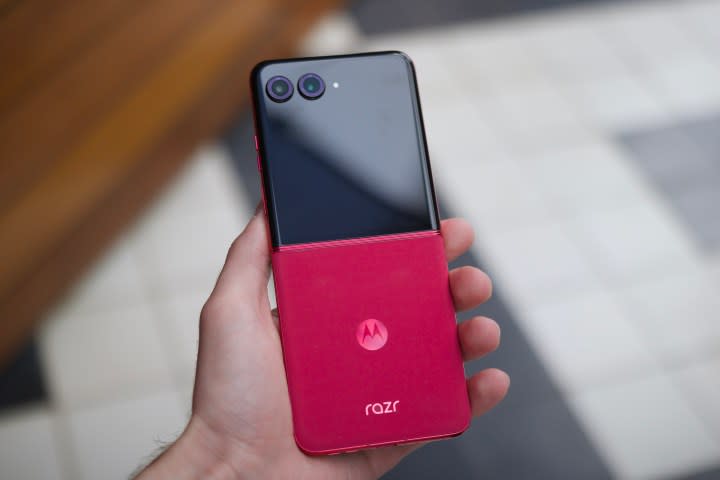
We’ll start with the Razr Plus 2024. At first glance, it looks a lot like the Razr Plus 2023. But there are key upgrades here. The cover display, for starters, has increased from 3.6 inches to 4 inches — the largest cover screen you can get on a flip phone today. It’s a small increase on paper, but in person, it feels significant. The cover screen now essentially takes over the entire front of the phone, minus the two cameras, and it’s really impressive. It also goes up to 120Hz.
And, finally, you enable an always-on display for the cover screen (and on the Razr 2024). Thank you, Motorola. Thank you.
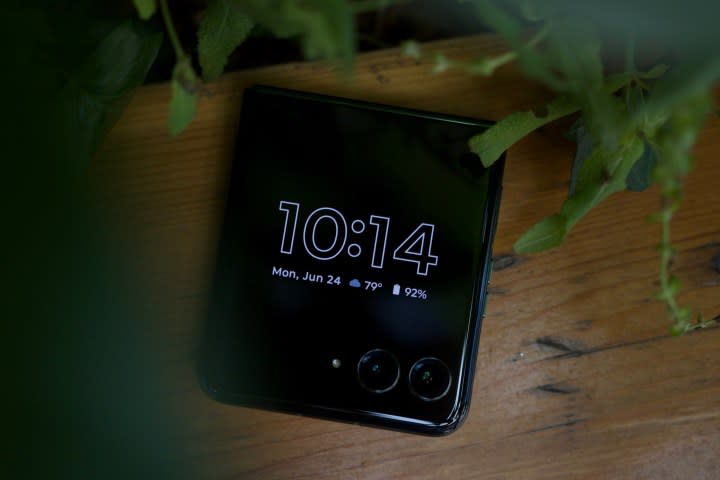
Speaking of the cameras, both phones have the same 50-megapixel primary camera. In place of an ultrawide camera like last year’s Razr Plus had, this year’s model gets a 50MP 2x telephoto camera. It’s an interesting change, but given how mediocre last year’s ultrawide sensor was, I don’t hate the decision to replace it with a higher-quality telephoto one. It seemed like a solid camera during my brief time using it in my hands-on session, but I’ll obviously need to dig into it a lot more in my review.
What I can immediately comment on is the new hinge. Motorola has an all-new hinge design for both the Razr Plus 2024 and Razr 2024. Motorola says the hinge mechanism is 30% smaller than last year’s, the crease is less noticeable, and that the phones are easier to flip open. And you know what? All of that is absolutely true.

The crease on the Razr Plus 2023 and Razr 2023 wasn’t bad by any means, but it’s virtually nonexistent on these new phones. The hinge also feels so much better. It’s smoother, it’s much easier to flip open with a flick of the wrist, and the two halves of the phone don’t move around when it’s closed. Combined with the new IP rating of IPX8 for both models (up from IP52 last year), it makes the Razr Plus 2024 and Razr 2024 feel more competent and complete.
What about the rest of the phone? The Razr Plus 2024 has a 6.9-inch pOLED display with a 165Hz refresh rate, HDR10+, and up to 3,000 nits of brightness. The Razr 2024’s main screen is nearly identical, with the only “downgrade” being a 120Hz refresh rate.
Other specs for the Razr Plus 2024 include a Snapdragon 8s Gen 3 chipset (the same one used in the Honor 200 Pro), 12GB of RAM, 256GB of storage, a 4000mAh battery, 50W wired charging, 15W wireless charging, and 5W reverse wireless charging.
A complete makeover for the Razr 2024
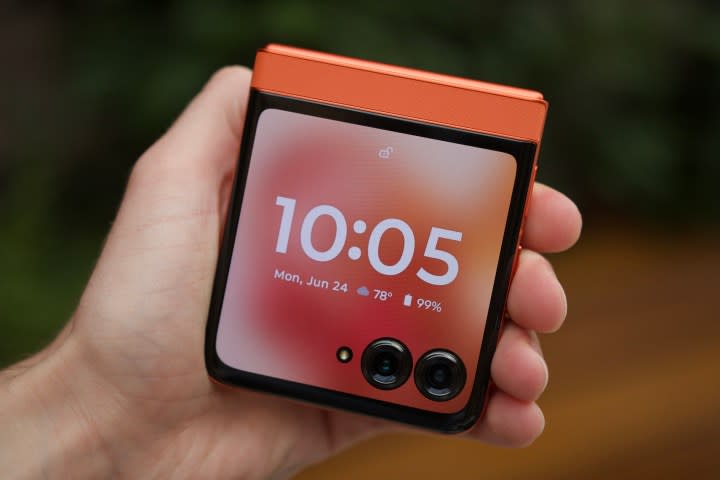
The biggest change for the Razr 2024 compared to the Razr 2023 is the cover screen. Where last year’s Razr had a teeny tiny 1.5-inch cover screen, the Razr 2024 has a 3.6-inch one with a 90Hz refresh rate. It’s essentially the same one used on the Razr Plus 2023. Now, instead of just being able to see notifications and check the time/weather, you can use a keyboard to reply to messages, see full-sized widgets, and run any app right on the cover screen. It’s the same cover screen experience you’ll find on the Razr Plus (2024) — including the always-on display — and it’s a fantastic year-over-year upgrade.
You don’t get the new telephoto camera that’s on the Razr Plus 2024. Instead, it’s a 13MP ultrawide/macro camera. You also have a larger 4200mAh battery, slightly slower 30W wired charging, and 15W wireless charging (but no reverse wireless charging).
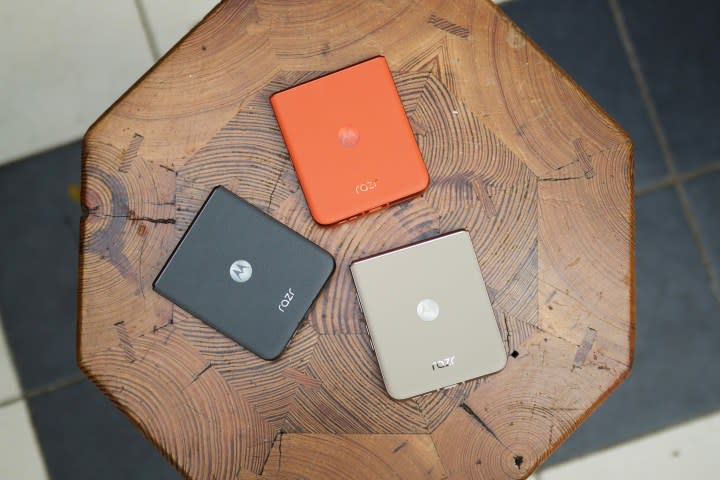
Powering the Razr 2024 is a MediaTek Diemsntiy 7300X chip. MediaTek just announced the 7300X last month, so it’ll be our first time using it in a phone. It’s a 4nm chip with an octa-core CPU and Arm’s Mali-G615 MC2 GPU. It should be a solid performer, and we’ll put it though its paces in our review. It’s joined by 8GB of RAM and 256GB of storage.
Otherwise, much of the Razr 2024 is identical to the Razr Plus 2024. The new hinge design, the 50MP main camera, the cover screen software, and the main display (minus the refresh rate) are all identical across the two phones. It’s really impressive feature parity, especially considering the prices.
Hello, Moto AI
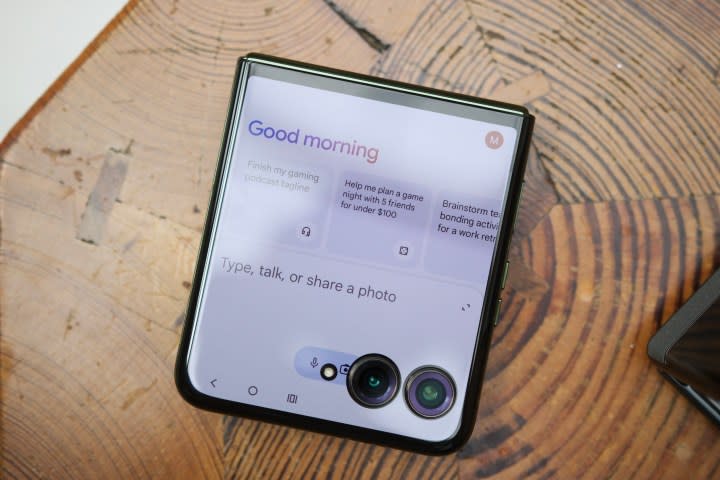
Yes, Motorola is getting into the AI game. The company is rolling out a bundle of features under the “Moto AI” umbrella, coming first to the Razr Plus 2024 and Razr 2024.
Many of the AI features are camera and photo-related. The Razr Plus, specifically, gets a “Photo Enhancement Engine” that’s supposed to improve dynamic range and detail, create nicer software-based bokeh effects, and reduce noise in lowlight shots. Motorola has some other AI tools to help with action shots, keeping a subject in focus in a video while they’re moving, and to improve stabilization.
Other AI tools include Google Gemini on both phones (right out of the box), an image generation app called Magic Canvas, and something called Style Sync — a feature that lets you take a photo of something, upload it, and get a few custom wallpapers based on that image. Motorola also showed off things like notification summaries and the ability to recall information from text conversations (not unlike Apple Intelligence), but these things seem to be coming at a later date.
Motorola Razr 2024 price and availability
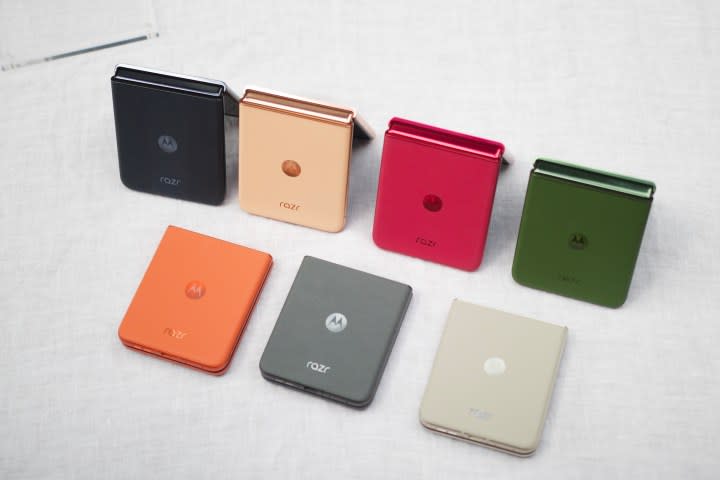
The Motorola Razr Plus 2024 costs the same $1,000 as before. The Razr 2024 also has the same price as last year, which is $700. Preorders begin on July 10, while general sales will start on July 24.
What about colors? The Razr Plus comes in Midnight Blue, Spring Green (my personal favorite), Hot Pink, and Peach Fuzz. The Razr comes in Koala Grey, Beach Sand, and Spritz Orange. These are all 10/10 names, by the way.
The Razr family still has it
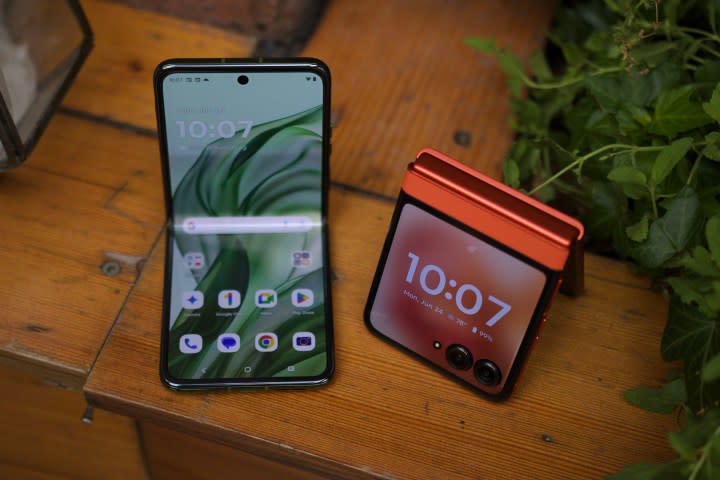
Just like last year, my first impressions of the Razr Plus 2024 and Razr 2024 are very positive. Last year’s Razr Plus was one of my favorite phones of 2023, and given that the Razr Plus 2024 is that same phone again but better, I’m really looking forward to spending more time with it. The Razr 2024 looks great, too. A bigger cover screen, a nicer camera, an improved chipset, and more for the same $700 price? That rocks.
If you’ve followed my Motorola coverage this year, you’ll know that 2024 has been a frustrating year for the company. From ad-filled software, lacking updates, and some really mediocre entries in the Moto G and the Motorola Edge families, I wasn’t sure what to expect going into the Razr 2024 lineup. Thankfully, Motorola proved to me that it’s still got it.
I don’t love that the new Razrs get just three years of Android upgrades, but after leaving my hands-on session, that’s the biggest complaint I can think of. The hardware is better than ever, the cameras seem promising, the specs look great, none of the bloatware from other Moto phones is anywhere to be found, and the prices are the same as last year. That’s a strong recipe for success.

Obviously, I need to spend more time with the Razr 2024 family before making any verdicts; that’s what reviews are for. But coming out of my hands-on session, I’m feeling pretty great about this year’s Razr lineup — plus Motorola’s ability to still kick out legitimately great smartphones. As a longtime Motorola fan and in a year that’s been so up and down for the company, that’s a damn good feeling.
